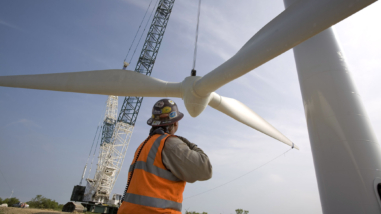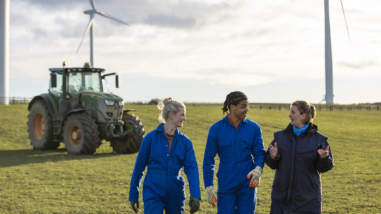What the Inflation Reduction Act means for climate and conservation in the U.S.

Today, President Joe Biden signed the Inflation Reduction Act into law. It is the largest climate bill in U.S. history and was made possible in part by the work of grantee partners who provided smart and timely policy analysis; built more diverse, inclusive, and effective coalitions; educated policymakers from across the political spectrum about climate and conservation issues; and never gave up hope that progress was possible.
Below two members of our Environment Program provide reflections on what today’s announcement means from a climate and conservation perspective.
Carrie Doyle, Senior Fellow, U.S. Climate: The Inflation Reduction Act is one of the most significant steps the country has taken on climate. Now the hard work of implementation begins.
The Inflation Reduction Act contains the building blocks to force a step change in U.S. decarbonization, bringing the country within range of meeting its international climate commitments. Once implemented fully, the Inflation Reduction Act will put the U.S. on a path to 40% emissions reductions by 2030 by creating incentives and making investments across all sectors deploying a broad range of technologies that climate scientists and organizations like the Intergovernmental Panel on Climate Change consider essential to decarbonization. As significantly, its clean energy tax credits are designed to drive benefits to workers.
The approach taken in the legislation is markedly different from past federal climate proposals. It is not just the greater focus on incentivizing technologies essential to decarbonization, but the expressed effort to drive investments into communities that don’t currently see themselves on the winning side of climate action. As our grantee Jesse Jenkins remarked in the Washington Post, “the new political opportunity is that this bill will deliver real benefits …,” illustrating “economic opportunity in the energy transition.”
For example, the bill invests over $60 billion in grants, loans, and tax credits to reduce emissions in the industrial sector and to incentivize domestic manufacturing across the supply chain of power and transportation technologies. Importantly, a portion of these investments will be directed to communities whose local economies are presently dependent on fossil fuels — an essential part of any effort to transform the energy sector as no community should be left behind in the shift to a green economy.
An additional $60 billion will support environmental justice priorities by driving investments into communities that have long called for tangible action to address systemic and historic exclusion. This funding includes block grants available to community-based organizations and tribal governments collaborating with communities facing environmental justice issues. The legislation also includes $20 billion for farmland conservation, alongside $500 million to support agriculture and climate research and development.
While the Inflation Reduction Act is largely good, it’s not perfect. That’s often the case with legislation that requires compromise. Parts of the bill run counter to climate goals, in particular, a commitment to expanded oil and gas lease sales on public lands and oceans. The tradeoff may seem worth it from a long-term emissions perspective, but that’s still cold comfort to the people whose economic and physical well-being depends on the ecosystems that will be degraded as a result of this compromise.
Even with this downside, however, today’s bill signing deserves celebration, especially of our many grantees from across the U.S. who have fought for years — decades — to make today possible. This was desperately needed legislation for the U.S. to make timely progress toward its goal of net-zero emissions by 2050, which means it is also critically important for global progress. As the New York Times wrote in a story that also quoted Jonathan Pershing, Hewlett’s Environment Program Director, the announcement “almost instantly resets the role of the United States in the global effort to fight climate change.”
Andrea Keller Helsel, Program Officer, Western Conservation: Our collective work to protect biodiversity and the ecological integrity of the North American West for nature and people isn’t done.
This law is a remarkable accomplishment for conservation of our lands and waterways, the restoration of wildlife habitat and our forests, and the well-being of communities throughout the United States.
First, the Inflation Reduction Act includes a major overhaul of the 100-year-old system that governs oil and gas leasing on public lands in the U.S. West. The law increases the royalty rate oil and gas companies must pay when leasing parcels of our public lands to develop oil and gas, which is fairer to U.S. taxpayers, among other reforms. The law eliminates “non-competitive leasing,” which has been used by some oil and gas companies to game the system by waiting for the federal agency that oversees leasing on public lands, the Bureau of Land Management, to offer leases unsold at auction at “fire sale” prices. Before this law, a company could purchase a lease to develop oil and gas for less than $2 per acre; no more!
The law also includes $4 billion for drought aid, especially for communities in the drought-ravaged Colorado River basin. This funding is essential right now to incentivize water users to use less water, help farmers and other water users deploy water efficiency projects, and fund wildlife habitat restoration projects.
But that’s not all. There are billions of dollars for extremely popular grant programs managed by the U.S. Department of Agriculture that incentivize private landowners to voluntarily restore streams and wildlife habitat on their property, remove invasive weeds, fix fences, and other conservation activities. The expansion of these programs will go a long way to conserving nature we all care about, including ensuring wildlife can safely migrate across the patchwork of public and private lands across the West.
Grantees and their partners helped make other significant provisions of the Inflation Reduction Act possible, including:
- $272.5 million in new funding for climate resiliency efforts, fish hatcheries, and drought mitigation programs in Native communities, including those in Alaska and Hawaii;
- $125 million for the U.S. Fish and Wildlife Agency to develop and implement recovery plans for wildlife listed under the Endangered Species Act, as well as additional funding for projects that support habitat and infrastructure in the National Wildlife Refuge System and State Wildlife Management Areas;
- $500 million for habitat restoration and land and water conservation projects led by the National Park Service and Bureau of Land Management; and
- Significant funding for managing forests and reducing wildfire risk in National Forests and investments in private and publicly owned forests as tools to absorb carbon and help mitigate the climate crisis — all further underscoring the value of conserving nature as part of the U.S.’s climate resilience strategy.
Despite all the good, there were some strings attached. To advance renewable energy projects, for example, the government will now require mandatory oil and gas lease sales at a scale that exceeds what the oil and gas industry may even want. It also requires sourcing an increasing fraction of battery critical minerals at home to be eligible for tax credits —a risk to Indigenous and rural communities and biodiversity already threatened by potential new mines.
The law obviously is not solving for all challenges to biodiversity, and with the aforementioned provisions, is exacerbating some of them and causing harm. Clearly, our collective work to protect biodiversity and the ecological integrity of the North American West for nature and people isn’t done. But we can still celebrate the years of hard work by our grantees and their partners. They successfully lifted up community-driven, durable solutions to conserving our lands and water, wildlife, and way of life. And because of that, we’ve made progress.



